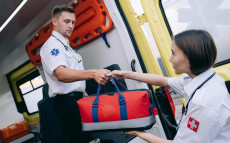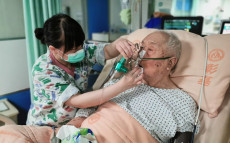- pathfindersAI
- Job Profile
Ambulance Drivers and Attendants, Except Emergency Medical Technicians
Summary
Ambulance Drivers and Attendants, Except Emergency Medical Technicians
What They Do
Ambulance drivers and attendants play a crucial role within the vast healthcare network by ensuring the safe and efficient transport of patients who require medical attention. Although they are not certified emergency medical technicians (EMTs), their duties are critically important to the continuity of care from the scene of an incident to a healthcare facility. Often, they are the first point of contact for patients in distress and work closely with EMTs and paramedics to provide a secure and reliable means of transportation. By maintaining the operational functionality of the ambulance and managing the logistics of patient transport, ambulance drivers and attendants ensure that medical emergencies are managed with precision and care.
Job Responsibilities
The responsibilities of ambulance drivers and attendants extend beyond merely driving. They are tasked with navigating various routes efficiently while considering the safety and comfort of the patient. Proper maintenance and inspection of the ambulance to ensure it is in optimal working condition are integral parts of their role. They often assist in moving patients into the ambulance and may help with basic patient care under the supervision of healthcare professionals. This includes using necessary equipment like stretchers and offering reassurance to anxious patients. Furthermore, they are responsible for documenting the journey and ensuring that all regulations and protocols are adhered to during patient transport.
Essential Skills
To excel as an ambulance driver or attendant, individuals must possess a unique set of skills. Proficient driving capabilities and a comprehensive knowledge of city routes and traffic laws are fundamental. Excellent communication skills are essential, as they must liaise with patients, medical staff, and dispatchers effectively. A calm demeanor and strong problem-solving abilities are crucial, particularly in high-pressure situations. Physical stamina and strength are necessary to lift and maneuver patients safely. Additionally, a basic understanding of medical procedures and first aid can be immensely beneficial. A humanitarian outlook and empathy are key traits, ensuring that patients feel supported and cared for during transport.
Educational Pathways
The educational requisites for becoming an ambulance driver or attendant are relatively straightforward compared to those of EMTs or paramedics. Typically, a high school diploma or GED is required. Many employers provide on-the-job training, although completing a basic first aid and CPR certification can be advantageous and sometimes necessary. Some community colleges and vocational schools offer specific programs or courses targeted at aspiring ambulance drivers and attendants. Additionally, a clean driving record and obtaining a specialized driver’s license, such as a commercial driver’s license (CDL) with endorsements for emergency vehicles, often form part of the employment criteria.
Career Prospects
Career prospects for ambulance drivers and attendants are promising, given the increasing demand for healthcare services. The aging population and the subsequent rise in emergency incidents and healthcare needs contribute to the growing necessity for qualified personnel in this field. Many ambulance drivers and attendants leverage their experience to advance into more specialized positions within the healthcare sector, such as EMTs, paramedics, or patient transport coordinators. Employment opportunities are diverse, spanning hospitals, private ambulance services, and government health departments. Moreover, with ongoing training and skill enhancement, individuals in this profession can expect stable employment and potential career growth.
Conclusion
In conclusion, ambulance drivers and attendants serve as vital cogs in the healthcare machinery, ensuring the smooth transit of patients requiring medical assistance. Their multifaceted roles extend beyond transportation, encompassing patient care, vehicle maintenance, and effective communication. By acquiring the necessary skills and fulfilling the basic educational prerequisites, individuals in this role can look forward to a rewarding career characterized by stability and opportunities for growth. As the healthcare landscape continues to evolve, the importance and demand for dedicated ambulance drivers and attendants will undoubtedly rise, cementing their indispensable status within the emergency medical services framework.
Video
Compensation
| State | Median Salary | Median Hourly | Positions |
|---|---|---|---|
| AL | 24,960 | 12.00 | 390 |
| AR | 30,290 | 14.56 | 40 |
| CA | 35,330 | 16.99 | 1,340 |
| CO | 36,510 | 17.55 | 90 |
| DE | 33,230 | 15.98 | 100 |
| FL | 34,600 | 16.64 | 140 |
| GA | 30,080 | 14.46 | 620 |
| IL | 32,580 | 15.66 | 550 |
| IN | 36,180 | 17.39 | 330 |
| IA | 33,740 | 16.22 | 330 |
| KY | 33,030 | 15.88 | 120 |
| LA | 30,020 | 14.44 | 130 |
| ME | 32,020 | 15.39 | 130 |
| MD | 37,500 | 18.03 | 510 |
| MA | 37,930 | 18.23 | 150 |
| MI | 30,010 | 14.43 | 70 |
| MN | 38,290 | 18.41 | 110 |
| MS | 26,120 | 12.56 | 380 |
| MT | 29,230 | 14.06 | 60 |
| NE | 31,680 | 15.23 | 40 |
| NV | * | * | 70 |
| NH | 35,570 | 17.10 | 100 |
| NJ | 37,810 | 18.18 | 300 |
| NM | 31,460 | 15.13 | 150 |
| NY | 34,510 | 16.59 | 630 |
| NC | 30,800 | 14.81 | 190 |
| ND | 28,870 | 13.88 | 130 |
| OH | 29,920 | 14.39 | 460 |
| OK | 28,970 | 13.93 | 200 |
| OR | 46,510 | 22.36 | 40 |
| PA | 30,050 | 14.45 | 540 |
| SC | 27,930 | 13.43 | 830 |
| SD | 29,120 | 14.00 | 120 |
| TN | 32,070 | 15.42 | 390 |
| TX | 31,240 | 15.02 | 260 |
| UT | 30,130 | 14.49 | 60 |
| VA | 29,370 | 14.12 | 180 |
| WV | 23,610 | 11.35 | 320 |
| WI | 32,020 | 15.39 | 450 |
| WY | 38,230 | 18.38 | 80 |
Similar Occupations
In this area you will find other occupations that are close to the one you were viewing in tasks, knowledge and work environment. If the primary job profile you are viewing isn't quite to your liking, take a look around and see what else is available.
Basic and Premium Accounts have more alternative occupations available than the Free account.

Emergency Medical Technicians - 29-2042.00
Emergency Medical Technicians (EMTs) are first responders trained to provide critical pre-hospital care in medical emergencies, ranging from trauma and cardiac incidents to respiratory distress and more. They assess patients, administer necessary medical interventions, and transport patients to healthcare facilities for further treatment.
-
$38,930/yr
Median Pay -
167,040
Number of Jobs

Nursing Assistants - 31-1131.00
Nursing Assistants provide essential care to patients by assisting with daily activities such as bathing, dressing, and feeding, as well as monitoring vital signs and reporting any changes in patient condition to the medical staff. They play a critical role in ensuring the comfort and well-being of patients in various healthcare settings, including hospitals, nursing homes, and long-term care facilities.
-
$38,200/yr
Median Pay -
1,351,760
Number of Jobs